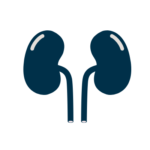From head to toe, prediabetes affects every major organ in your body. Blood sugar is high up on the food chain of importance. If blood sugar is disrupted, all the downstream processes become affected as well. The more you understand how influential blood sugar levels are to overall health, the more your symptoms start to make sense.
Symptoms: Your internal guidepost
Your body speaks in the language of symptoms. It communicates when your blood sugar levels are off with sudden changes in energy, hunger, and mood. Some symptoms many you can feel within the same day, while others take longer to develop.
Understanding how prediabetes affects your body helps you increase your body literacy and recognize the relationship between blood sugar balance and physiological functions. It’s a beautiful feeling to listen to your body’s language and learn how it functions best.
We’ve mentioned before that prediabetes is driven by insulin resistance. Insulin resistance is a state where the cells are slow to respond to the blood-sugar-lowering signal of insulin. Therefore, blood sugar levels remain high AND more insulin is signaled to enter the blood. Prediabetes typically increases your baseline insulin and blood sugar levels. The symptoms of prediabetes are a result of high blood insulin levels, high blood sugar levels, or both.
Your body does NOT like extra sugar and insulin floating around in the blood. It views them as a stressor and turns up the level of inflammation in the body. Short-term inflammation is your body’s way of protecting you. When this inflammation is present over time, it puts stress on your major organs, which opens the door to future chronic diseases like diabetes, kidney disease, and heart disease.
Since the blood supplies our organs with nutrients, the imbalance in the blood’s chemistry is also felt by the organs it supplies. The three classic symptoms of prediabetes are more frequent hunger, thirst, and urination.
ten manifestations of blood sugar disturbance

1. energy
One of the first obvious symptoms of blood sugar disturbances is changes in energy. Your body feels its best when your blood sugar range is tightly controlled. Blood sugar range refers to your lowest level to your highest level. You will FEEL any outliers in that range.
Blood sugar spikes are the notable contributors to prediabetes symptoms. A blood sugar spike occurs when quickly skyrockets upwards as sugar floodgates are unleashed into the blood. Since insulin is released after sugars enter the blood, insulin levels mirror the blood sugar spike. The higher the blood sugar spikes, the more insulin it’ll shoot out to lower the blood sugar. A blood sugar spike is felt with fatigue, frequent bathroom trips, headaches, and blurry vision.
After insulin does its job and your blood sugar returns to normal, the leftover insulin will continue to do its job, dropping blood sugar to dangerously low levels. This is the scientific description of a blood sugar crash; it’s accompanied by feelings of fatigue, sleepiness, hunger, and irritation.
Fatigue is a consequence of hyperglycemia and hypoglycemia, i.e., high and low blood sugar. Your body does not like your blood sugar at either end of the extreme. It wants a happy medium.

2. Mental health
Experiencing a large blood sugar range suggests that you experience blood sugar spikes or dips throughout the day. This rollercoaster fluctuation is linked to headaches, brain fog, poor concentration, irritation, anxiety, brain fog, sleep problems, and headaches/migraines.
High blood sugar may even correspond to mental health symptoms such as anxiety attacks. In a previous article, we outlined that depression and anxiety are recognized by the body as a form of psychological stress, which is responded to by rising blood sugar levels. We also discussed the two-way relationship between depression and diabetes: depression increases an individual’s risk for diabetes and vice versa.
Therefore, the blood sugar disturbance from prediabetes can worsen pre-existing mental health conditions and may increase your risk of developing other mental health concerns.
As your blood sugar levels rise and fall, you may notice a change in your mood, anxiety, and depression. Certain medications for depression, i.e., antidepressants, may interfere with your ability to control your blood sugar levels. Talk to your healthcare provider to discuss an option that treats both prediabetes and your mental health concerns.

3. Vision
Similarly to a camera, the lens of our eyes must focus to clarify an image. When any lens is clouded with fog, the image becomes blurred.
High blood sugar levels with prediabetes build up pressure around the most sensitive area of your body — your eyes. Pressure builds up inside the eyes, fluid is retained, and fog develops.
In addition to blurry vision, you may also experience headaches, eye aches, and water eyes. If you’re experiencing any of these symptoms, including an eye doctor in your care is critical to reverse the damage.
High blood sugar causes the lens of the eye to swell, which changes your ability to see. To correct this kind of blurred vision, you need to get your blood sugar back into the target range. It may take up to 3 months to notice an improvement in vision

4. Sleep
The relationship between sleep and blood sugar levels is complex. Studies have linked sleep disorders, like sleep apnea, with an increased risk of developing elevated blood sugar levels. Even poor sleep quality in children is linked to an increased risk for prediabetes and diabetes.
A 2019 study found that 62% of people with blood sugar levels in the pre-diabetic range experienced poor sleep quality, while 46% of people with normal blood sugar levels had better sleep quality (PMID: 31546116).
Therefore, the relationship goes both ways: sleep may interfere with blood sugar control and blood sugar control may interfere with sleep.
Bottom line, sleep is a BIG deal when you’re looking to lower your a1c and feel your best.

5. skin
Since your skin is your largest organ, it will undoubtedly be sensitive to changes in blood sugar.
The classic presentation of insulin resistance on the skin is called Acanthosis Nigrican. It presents as darker skin patches that feel velvety that appear on creases of the body, like the underarms, back of the neck, or groin.
Since blood sugar disturbances increase the level of inflammation in the body, prediabetes increases your risk for inflammatory skin conditions, such as acne, eczema, and psoriasis. The evidence suggests that the hormonal changes that happen with insulin resistance, especially in younger men, increases the production of acne lesions. People with eczema and psoriasis, both itchy, scaly skin conditions, are also more likely to develop diabetes. If you’re experiencing any of these symptoms, it’s best to get evaluated by a dermatologist.
The pro-inflammatory state of prediabetes makes you more vulnerable to infections. On top of that, prediabetes interferes with your body’s ability to heal wounds properly. Since prediabetes damages circulation and nerves, by default, it slows down the supply of blood to the wounded area. See symptom #8 “infections” below to learn more.
Hair growth in unwanted places and hair thinning in wanted places are common concerns relayed with prediabetes. The lifecycle of a hair follicle is VERY complex and requires enough blood to flow through to supply it with the oxygen and nutrients it needs to flourish. When blood sugar levels are elevated, the delivery of oxygen and required nutrients is halted. This promotes slow hair growth, hair thinning, and baldness but it typically take a few months to manifest.

6. digestion
The constant spike and crash in blood sugar amplify feelings of thirst, hunger, and cravings for sugar. Hunger after eating is a signal that your blood sugar levels increased BUT your body is not extracting the nutrients from your foods efficiently.
Since your blood sugar is elevated, your body will work to rid itself of extra sugar via urination. This dehydrates you and sends your brain a thirst signal. This is simply another reason to ensure your keeping up with water intake — especially during the dehydrating summer months. Other symptoms that occur in the mouth include a sweet taste, gum disease, oral thrush (mouth infection), and recurring mouth sores. This is particularly why oral health is important to keep up with.
About 75% of people with prediabetes have been found to experience some kind of stomach or gastrointestinal symptoms with diarrhea, heartburn, and constipation as the top contenders. A 2018 study found that people with prediabetes display more frequent symptoms of bloating, early satiety, nausea, heartburn, excess gas, and constipation. The most frequent symptom I’ve seen in practice is heartburn or acid reflux, which is characterized by acidic backflow into the mouth causing pain in the upper abdomen.
These symptoms may be explained by an imbalance of good and bad bacteria in your large intestine, also known as the “gut microbiome.” Gut health is all the rage these days but it’s been shown to be especially relevant for people with prediabetes. Studies have consistently proven that people with prediabetes have more “bad” bacteria than good bacteria. Scientists have linked levels of inflammation, metabolic function, and diabetes to gut health. Therefore, targeting gut health has the potential to shape the future of prediabetes reversal and diabetes management.

7. Nervous system
The nervous system is your body’s command center. It’s in charge of mobilizing your organs to complete tasks of daily living, like running, walking, and eating. It’s made up of a network of nerves that function as tiny cables to send communication signals from your brain all the way down to your toes. Nerves are intertwined with blood vessels and exposed to blood sugar levels.
Since nerves are delicate little creates sensitive to any changes that happen in their environment, dramatic changes in blood sugar and blood flow affects their function. Therefore, a rise in blood sugar can damage your nerves.
Overtime, constant exposure to high blood sugar levels damages the communication signals to body parts furthest from the heart; this is referred to as diabetic neuropathy.
Numbness and tingling in the feet are often one of the most common clinical presentations of diabetic neuropathy though it may also affect hands, legs, and arms.

8. infections
High blood sugar levels inhibits the function of immune cell that fight infections, increasing your risk for infections. Bacteria also love sugar and feed on it to grow, which rapidly multiplies the presence of bacteria. If an infection enters the body, the decrease in immune function couples with bacteria’s affinity for sugar multiples your risk for lung, skin, urinary, genital, and dental infections.
On top of the increased risk for infections, prediabetes also delays the healing process of wounds. The extra sugar in the blood present with prediabetes thickens the blood’s consistency, slowing down overall blood flow and circulation. Wounds require adequate blood supply to heal properly and quickly. The slow rate of blood supply delays the supply of nutrients from the blood to the wounded area.
This also means that any kind of cut or laceration on areas of numbness can can quickly lead to an infection or ulcer if left untreated. That’s why it is especially important to routinely check areas you’re prone to numbers for cuts so that they can be treated early.

9. Reproduction
Many studies and reviews have found a strong relationship between prediabetes and the presence of erectile dysfunction (ED). A 2018 study found that 20% of men newly diagnosed with ED are concurrently living with undetected prediabetes or already hold a prediabetes diagnosis. The elevated blood sugar status in people with ED is thought to damage the health of the sperm and decrease fertility.
Polycystic Ovarian Syndrome (PCOS) is a complex hormonal, metabolic, and genetic condition that is highly prevalent among women with prediabetes. The data suggest a two-way relationship between PCOS and prediabetes: PCOS may increase your risk of prediabetes and vice versa.
According to the American Diabetes Association, elevated blood sugar levels increase a woman’s risk of miscarriage by 30-60 percent. Congenital fetal malformations are a major concern in women with uncontrolled sugar levels.
High blood sugar may also welcome the overgrowth of yeast in the vaginal area. Since yeast feed on sugar, high blood sugar over time increases your risk for recurring yeast infections.
Prediabetes may also affect period health and regularity. Irregular periods are a significant PCOS symptom so it’s best to rule out PCOS if you’re experiencing irregular periods. Irregular periods are also seen among people who eat too little calories or over-restrict carbohydrates. Your period is highly sensitive to how nourished you are so if your body notices any deficits in food intake or high stress levels, you will likely experience changes in your period. If your period is absent for 3 or more months, I HIGHLY recommend you get evaluated by a gynecologist.

10. kidneys
The kidneys are heavily involved in keeping your blood sugar levels happy. Their main function is to filter the blood.The kidneys are made up of a very fragile network of blood vessels, called the glomerulus.
The blood flows into the glomerulus to be filtered. The glomerulus recycles reusable nutrients back into the blood, like proteins, and sends waste to exit as urine.
When blood sugar increases after a meal, your body recruits your kidneys as one of the ways to lower blood sugar levels. The kidneys get a signal to flush out excess sugar via urine.
Since blood with prediabetes is more concentrated in sugar, the consistency of the blood thickens. Thicker blood raises blood pressure.
Therefore, the thick, sugar-rich blood enters the kidney with intense force, damaging the fragile vessels in the glomerulus. The excess sugar is flushed out but the more sugar you need to flush out, the higher your risk for dehydration. Over time, constant exposure to this high pressure and thick blood interferes with the filtration process of the glomerulus.
Urine tests are often done by your doctor to look for any proteins that may have escaped the glomerulus to enter the urine instead of being recycled into the blood. Constant damage over time eventually increases your risk for kidney disease.
No symptoms
Although symptoms can help us identify prediabetes early, many people live with prediabetes unnoticed. Since everyone’s body is unique, there are a subset of people that have no symptoms with prediabetes. Therefore, if you have a strong family history of prediabetes or are concerned at all about your health, it’s best to routinely request a A1C test at your yearly physical.
Conclusion
Blood sugar has the power to transform your quality of life, including the health of your brain, sleep, energy, digestion, and so much more.
The goal with eating to feel your BEST is to minimize glucose spikes and drops such that you minimizes inflammation, prevent symptoms associated with blood sugar disturbances, and support your long-term health. This way of eating is referred to as practicing blood sugar balance, despite having prediabetes or not.
Check out THIS article to learn how to eat all your favorite carbs in a way that balances your blood sugar and tights your blood sugar range to optimize how you FEEL and prevent long-term health conditions that follow prediabetes.
Follow us on Instagram and TikTok to learn more nutrition tips daily. Feel free to submit any questions here or leave a comment below.

Disclaimer: this website and blog post is not meant in any way to substitute medical care. If you suffer from any of these symptoms or suspect you have prediabetes or diabetes, please check with your primary care physician.
